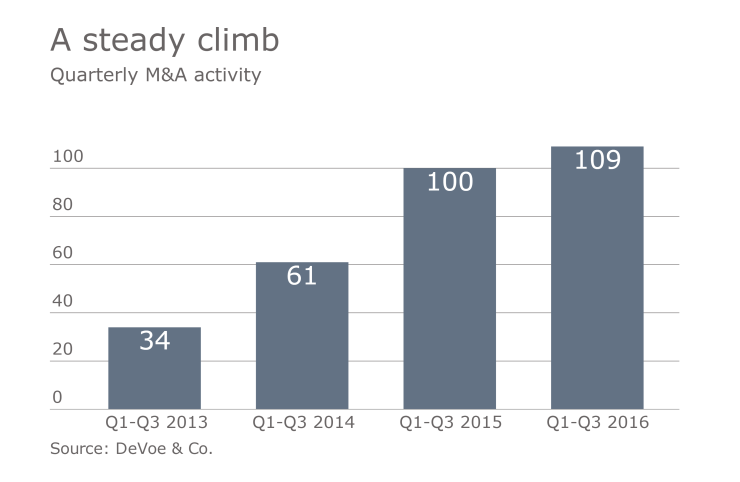When it comes to the future of their practice — and the advisory industry — what are planners most concerned about? Even more importantly, what can they do now to prepare?
I sat down with Ric Edelman, CEO of Edelman Financial Services and a top independent adviser, to discuss the key questions and worries we’re hearing from advisers. Here are some of the insights we gained.
Will there be more competition going forward, or less?
Our industry is going through a major evolutionary process. Competition is getting more intense. There are greater challenges with technology, the regulatory environment and in the markets.
Many of you may be first-generation RIAs. Those of us in that category invented the business, and we had it to ourselves for a long time.
The mom-and-pop shops of the past are morphing into bigger businesses.
Well, that party is over. Advisers today often don’t want to build their own firms, but instead join existing ones so they don’t have to hustle to find new clients, as we did. So the mom-and-pop shops of the past are morphing into bigger businesses, much as smaller accounting firms ultimately grew into regional players.

The days of being a successful sole practitioner with 100 clients managing a couple hundred million bucks are going, if not gone already. Advisers in that position will not be able to provide the services and technology tomorrow’s clients want. They also can’t manage the branding that will help keep current clients or add new ones. The only types of firms that will make it using this model will be those that are extremely specialized in serving a highly profitable niche.
Will the robos replace flesh-and-blood advisers?
It’s unlikely that the standalone robos have a sustainable business model. They’ll likely struggle to stay in business once their venture capital dries up. Many have already been acquired by a big player. Others are changing their business model radically to be economically viable.
Blockbuster industry deals and unforeseen shifts in client attitudes are altering future forecasts for digital advice.
Still, investor demand for a robo-based approach will be robust enough to make this a viable advice channel, but likely with a different business model. So the notion of technology-driven advice is here to stay. You can’t ignore it or say you’ll do a better job than any technology offering. If you haven’t already, move to incorporate the technology into your practice in some way.
This applies to higher-end advisers, as well as those serving the mass affluent. Robos are already adding value in areas including estate and charitable planning, both things that more-affluent clients tend to want to address.
What type of adviser will prevail — the generalist or specialist?
Both can win, depending on how advisers leverage these models. Generalists will need to have very large practices, with multiple locations that have a consistent look, feel and experience.
Edelman sees these firms as the Starbucks of the financial services world. Just as customers know exactly what they’ll get when they go into any Starbucks, clients of generalists will know what the experience will be at every step.
Specialists will do very well if they pick the right niches and establish themselves as true experts and authorities.
In contrast, specialists will do very well if they pick the right niches and establish themselves as true experts and authorities in those markets, through content marketing and the right positioning. Alliances with other professionals who serve their chosen niche — including CPAs and attorneys — will also be instrumental sources of new-client introductions.
Now we come to some top adviser concerns. The concerns we most often hear about tend to fall into the following five categories.
Delivering a high-quality experience.
Advisers are well aware that a great client experience is vital if they want to differentiate themselves. However, it’s become significantly more challenging to deliver that exceptional experience. In the 1970s, for example, advisers typically were deemed outstanding if they helped clients select investments and set the right asset allocation, then conducted regular portfolio reviews.
When offering a market perspective or sitting down with a client for a portfolio review, word choice can make all the difference.
Today, advisers have to address investments and advanced non-investment issues such as estate, retirement and insurance planning. Many affluent investors won’t even consider working with an adviser who cannot accomplish these tasks.
Addressing this concern requires having systems in place to make your client experience replicable and scalable. If you can’t do something the same way 500 times, don’t do it.
That doesn’t mean becoming a cookie-cutter practice, however. It simply means delivering excellence every time. Advisers often need to narrow what they offer and to whom they offer it. —for example, by serving one unique niche market or specializing in a particular solution.
If a prospect isn’t aligned with what you offer and who you are, don’t take them on. All decisions about who you are and what you do should be made around whom you are ideally suited to serve.
Building stronger relationships with existing clients.
Advisers are (finally) beginning to see that they must engage with clients’ extended families — spouses, children and even grandchildren —to retain accounts and assets. Failure to do so can be extremely costly. It’s not uncommon to see advisers lose half of a household’s assets when a spouse dies.
CEG Worldwide research found that advisers report having 15 touches with their clients, on average, annually. But guess how many check-ins the affluent actually want to have? It’s 28.

Here, again, you need a system in place to reach out. Financial matters can be handled in person, via email, through webinars and through live presentations, seminars and client events.
But there should also be communications that focus entirely on the client — his or her life, family, etc. The affluent want to know they are more than just an AUM number to you. Cards, emails, quick videos made from your phone — these can all reinforce the adviser-client relationship.
Improving client satisfaction.
One of the most effective and obvious, yet most overlooked, ways to improve client satisfaction is to measure it in the first place. Client satisfaction surveys, done annually, can help you assess your strengths and, more important, your weaknesses.
Significantly growing AUM.
This task is also proving to be more difficult than ever.
Ask yourself how you spend your time. If you’re dealing with back-office duties and copiers and phones and routers, you’re not putting the focus on where it needs to be: getting new clients and getting more from existing clients.
For everything else that isn’t client-focused — human resources, trading, compliance and so on — you should be hiring others. Still need convincing? our research has shown that advisers who increased their focus on business operations saw an average income drop of $13,567.
Attract qualified prospective clients.
Placing significant focus on new-client attraction yielded an estimated average increase of $10,441 in annual net income, according to CEG Worldwide research.
-
The first 100 days are critical to keeping a new client for life … or watching them jump to a competitor.
November 8 -
A mix of approaches to gain the attention of ideal prospects, who have learned to ignore typical marketing tactics.
May 26 -
No adviser alone can be an expert for all clients' needs. Here’s how to build a network of fellow professionals, influencers and experts.
August 5
The key is to get in front of the right clients, those you can serve exceptionally well and who will pay you well for doing so. Too often, advisers focus on bringing on as much new business as they can. Typically, many of these clients don’t have the amount of assets needed to compensate advisers adequately for their time.
Meanwhile, advisers are so busy trying to serve all these clients that they don’t have the time or resources to pursue the larger, more profitable clients. The end results: stagnant growth, overworked advisers, subpar client service and diminished profits.
Overall, staying nimble and flexible, and always looking ahead to future trends, will help put advisers on the path to great success.







